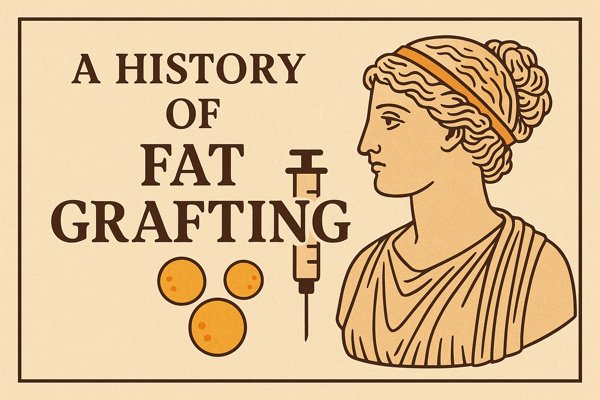A History of Fat Grafting
Though you may not know much about it, fat grafting has become increasingly popular in recent years. Board-certified plastic surgeons find it highly effective for reconstructive applications for the breast and face, congenital anomalies, and treating post-radiation and burn injuries.
But it’s also effective for a wide variety of aesthetic applications, including breast augmentation, facial and body contouring, and many more.
While it’s a relatively common plastic surgery procedure today, the history of fat grafting goes back over a century.

What Is Fat Grafting?
Fat grafting involves three steps.
In the first step, fat is extracted from a donor area of the body using thin liposuction cannulas with small holes.
The fat is then processed with decanting and centrifugation, or is washed with a sterile saline solution. Both methods serve to discard debris and fat cells that are unlikely to survive and can later create problems.
Finally, small droplets of the fat are injected into the subcutaneous tissue of the recipient area. Doing so encourages good blood supply to the droplets so they can survive in this new area.
The History of Fat Grafting Starts in the 1890s
The early days of fat grafting were, well, dicey. In 1893, a German surgeon, Gustav Neuber, transferred fat from the arm to the face to correct scarring – thus performing the first documented fat grafting procedure. He was followed in 1895 by Dr. V. Czerny, who performed an early form of breast reconstruction by transferring a lipoma from the buttocks to the breasts.
There were numerous other surgeons experimenting with grafting fat cells to the breasts and other areas of the body. But the survival rates of the patients weren’t promising. Liposuction did not exist, and ‘cleaning’ the extracted fat was far from perfected.
The Early 20th Century
In 1909, Eugene Holländer introduced new injection techniques. There continued to be high reabsorption rates and the extracted fat was often of inconsistent quality. As a result, the formation of cysts became more common. As such, fat grafting had trouble gaining acceptance during the next 50 years.
The first scientific studies regarding fat graft survival were done in 1950 when surgeons began experimenting with dermo-fat grafts into the breasts. These were large clumps of skin and fat that were transferred together. This often resulted in the death of the fat that would cause breast lumps with calcification. Such lumps were difficult to distinguish from breast cancer.
So fat grafting was tabled for a while.
Liposuction and Fat Grafting in the Late 20th Century
By 1975, the development of modern suction-assisted lipectomy (fat removal) paved the path for more efficient ways to harvest fat. Techniques continued to be refined, and the 1980s brought the invention of liposuction. Even so, results were still inconsistent.
As such, the American Society of Plastic Surgeons (ASPS) placed a moratorium on the use of fat grafting to the breasts in 1987. By this time, silicone implants were widely available so surgeons utilized those in most augmentation and reconstruction procedures.
In the 1990s, Dr. Sydney Coleman, a New York City plastic surgeon, published papers detailing standardized techniques for fat extraction, processing, and injection. Fat grafting began to gain in popularity and effectiveness for a variety of applications.
A New Century and Millennium
In 2001, Dr. Coleman published a book titled “Structural Fat Grafting,” illustrating a technique of fat harvesting and grafting that resulted in a high survival rate of fat cells. By 2008, ASPS had reversed its 20-year moratorium and in 2009, French surgeon Dr. Emmanuel Delay reported on his personal experience with nearly 1000 fat injection breast procedures over the previous ten years – effectively proving that fat grafting to the breast was considered safe and effective.
Just ten years ago in 2013, Patrick Tonnard and his group reported on another new technique for preparing and using fat tissue called “nanofat.” What’s next in the area of fat grafting? Only time will tell.
Could You Use a Little More Volume?
Understanding the history of fat grafting makes it clear that it’s now a safe and effective procedure for adding fullness and volume.
That’s why plastic surgeons often utilize it for various cosmetic and reconstructive purposes, including facial rejuvenation, breast augmentation, and correcting contour deformities from trauma or surgery.
So if you’re ready to explore the benefits of fat grafting for you, contact us today.











